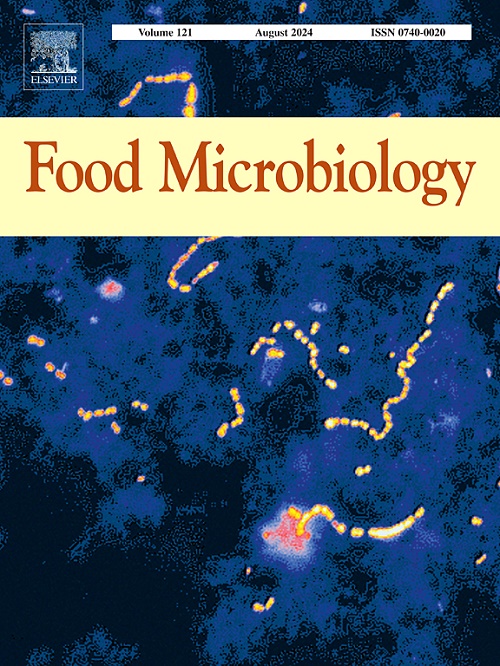巴氏杀菌法对灭活生鲜全脂牛奶中 H5N1 流感病毒的效果
IF 4.5
1区 农林科学
Q1 BIOTECHNOLOGY & APPLIED MICROBIOLOGY
引用次数: 0
摘要
高致病性禽流感 (HPAI) 2.3.4.4b 支系 H5Nx 病毒继续造成偶发性入侵,已在超过 12 个分类目中检测到,涵盖 80 多个禽类物种、陆地和海洋哺乳动物,包括哺乳期奶牛。高致病性禽流感 H5N1 病毒扩散到奶牛身上为人类接触病毒创造了新的机会,并引发了食品安全问题。美国五份零售巴氏杀菌牛奶样本中有一份含有 H5N1 基因物质,这促使人们对巴氏杀菌灭活流感病毒的过程进行评估。我们的研究考察了巴氏杀菌法能否有效灭活添加到生全脂牛奶中的高致病性禽流感 H5N1 病毒。首先,我们将 1 毫升非均质化牛奶样本加热至内部温度 63°C 或 72°C,并添加 6.3 log10 EID50 的 2.3.4.4b 支系 H5N1 病毒。加有 H5N1 病毒的生乳在 63°C 孵育 30 分钟后,病毒即被完全灭活。此外,在 8 个实验重复中,有 7 个在 72°C 处理 15 秒后观察到病毒灭活。在其中一个重复中,病毒数量减少了 4.44 log10,比疫区散装牛奶中检测到的平均病毒数量高出约 1 log。因此,我们得出结论,对牛奶进行巴氏杀菌是降低人类接触受 H5N1 病毒污染的牛奶的风险的有效策略。本文章由计算机程序翻译,如有差异,请以英文原文为准。
Effectiveness of pasteurization for the inactivation of H5N1 influenza virus in raw whole milk
Highly pathogenic avian influenza (HPAI) clade 2.3.4.4b H5Nx viruses continue to cause episodic incursions and have been detected in more than 12 taxonomic orders encompassing more than 80 avian species, terrestrial and marine mammals, including lactating dairy cows. HPAI H5N1 spillover to dairy cattle creates a new interface for human exposure and raises food safety concerns. The presence of H5N1 genetic material in one out of five retail pasteurized milk samples in the USA has prompted the evaluation of the pasteurization processes for the inactivation of influenza viruses. Our study examined whether pasteurization could effectively inactivate HPAI H5N1 spiked into raw whole milk. First, we heated 1 mL of non-homogenized cow milk samples to attain an internal temperature of 63°C or 72°C and spiked with 6.3 log10 EID50 of clade 2.3.4.4b H5N1 virus. Complete inactivation was achieved after incubation of the H5N1 spiked raw milk at 63°C for 30 min. In addition, viral inactivation was observed in seven of eight experimental replicates when treated at 72°C for 15s. In one of the replicates, a 4.44 log10 virus reduction was achieved, which is about 1 log higher than the average viral quantities detected in bulk milk in affected areas. Therefore, we conclude that pasteurization of milk is an effective strategy for mitigation of the risk of human exposure to milk contaminated with H5N1 virus.
求助全文
通过发布文献求助,成功后即可免费获取论文全文。
去求助
来源期刊

Food microbiology
工程技术-生物工程与应用微生物
CiteScore
11.30
自引率
3.80%
发文量
179
审稿时长
44 days
期刊介绍:
Food Microbiology publishes original research articles, short communications, review papers, letters, news items and book reviews dealing with all aspects of the microbiology of foods. The editors aim to publish manuscripts of the highest quality which are both relevant and applicable to the broad field covered by the journal. Studies must be novel, have a clear connection to food microbiology, and be of general interest to the international community of food microbiologists. The editors make every effort to ensure rapid and fair reviews, resulting in timely publication of accepted manuscripts.
 求助内容:
求助内容: 应助结果提醒方式:
应助结果提醒方式:


